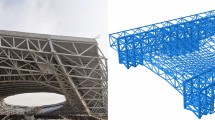Abstract
A novel damage detection algorithm for structural health monitoring using time series model is presented. The proposed algorithm uses output-only acceleration time series obtained from sensors on the structure which are fitted using Auto-regressive moving-average with exogenous inputs (ARMAX) model. The algorithm uses Cepstral distances between the ARMAX models of decorrelated data obtained from healthy and any other current condition of the structure as the damage indicator. A numerical model of a simply supported beam with variations due to temperature and operating conditions along with measurement noise is used to demonstrate the effectiveness of the proposed damage diagnostic technique using the ARMAX time series models and their Cepstral distances with novelty indices. The effectiveness of the proposed method is validated using the benchmark data of the 8-DOF system made available to public by the Engineering Institute of LANL and the simulated vibration data obtained from the FEM model of IASC-ASCE 12-DOF steel frame. The results of the studies indicate that the proposed algorithm is robust in identifying the damage from the acceleration data contaminated with noise under varied environmental and operational conditions.














Similar content being viewed by others
References
Lynch J P, Sundararajan A, Law K H, Kiremidjian A S and Carryer E 2004 Embedding damage detection algorithms in a wireless sensing unit for attainment of operational power efficiency. Smart Mater. Struct. 13(4): 800–810
Straser E G and Kiremidjian A S 1998 Modular wireless damage monitoring system for structures, Report No. 128, John A. Blume Earthquake Engineering Center, Department of Civil and Environmental Engineering, Stanford University, Stanford, CA
Doebling S W, Farrar C R, Prime M B and Shevitz D W 1996 Damage identification and health monitoring of structural and mechanical systems from changes in their vibration characteristics: A literature review, Los Alamos National Laboratory Report LA-13070-MS, Los Alamos National Laboratory, Los Alamos, NM 87545
Sohn H, Farrar C R, Hunter H F and Worden K 2001 Applying the LANL statistical pattern recognition paradigm for structural health monitoring to data from a surface-effect fast patrol boat, Los Alamos National Laboratory Report LA-13761-MS, Los Alamos National Laboratory, Los Alamos, NM 87545
Sohn H and Farrar C R 2001 Damage diagnosis using time series analysis of vibration signals. Smart Mater. Struct. 10: 446–451
Fassois S D and Sakellariou J S 2007 Time series methods for fault detection and identification in vibrating structures. Roy. Soc. Philos. Trans.: Math., Phys. Eng. Sci. 365: 411–448
Ljung L 1999 System identification: Theory for the user. 2nd edn, Prentice Hall
Carden E P and Brownjohn J M 2008 Arma modelled time series classification for structural health monitoring of civil infrastructure. Mech. Syst. Signal Process. 22(2): 295–314
Zhang Q W 2007 Statistical damage identification for bridges using ambient vibration data. Comput. Struct. 85: 476–485
Bodeux J B and Golinval J C 2001 Application of ARMAV models to the identification and damage detection of mechanical and civil engineering structures. Smart Mater. Struct. 10: 479–489
Zheng H and Mita A 2007 Two stage damage diagnosis based on the distance between arma models and prewhitening filters. Smart Mater. Struct. 16: 1829–1836
Sakellariou J S and Fassois S D 2006 Stochastic output error vibration based damage detection and assessment in structures under earthquake excitation. J. Sound Vib. 297: 1048–1067
Fung Eric H K, Wong Y K, Ho H F and Mignolet Marc P 2003 Modelling and prediction of machining errors using ARMAX and NARMAX structures. Appl. Math. Modell. 27: 611–627
Zhenhua Xing Y Z and Akira Mita 2012 A substructure approach to local damage detection of shear structure. Struct. Control Health Monit. 19(2): 309–318
Ay Ali M and Wang Ying 2014 Structural damage identification based on self-fitting ARMAX model and multi-sensor data fusion. Struct. Health Monit. 13(4): 445–460
Oppenheim A V and Schafer R W 1975 Digital signal processing. Prentice-Hall, London, UK
Luke Dosiek and John W Pierre 2013 Estimating electromechanical modes and mode shapes using the multichannel ARMAX model. IEEE Trans. Power Syst. 28(2): 1950–1959
Martin R J 2000 A metric for ARMA processes. IEEE Trans. Signal Process. 48: 1164–1170
Johnson E A, Lam H F, Katafygiotis L S and Beck J L 2004 Phase I IASC-ASCE structural health monitoring benchmark problem using simulated data. J. Eng. Mech.130: 3–15. DOI: 10.1061/(ASCE)0733-9399(2004)130:1(3)
Futao Zhu and Yunjie Wu 2014 A rapid structural damage detection method using integrated ANFIS and interval modeling technique. Appl. Soft Comput. 25: 473–484
Nair K K, Kiremidjian A S and Law A S 2006 Time series-based damage detection and localization algorithm with application to the ASCE benchmark structure. J. Sound Vib. 291: 349–368
Bernal D and Gunes B 2004 Flexibility based approach for damage characterization: benchmark application. J. Eng. Mech.-ASCE 130: 61–70
Hera A and Hou Z K 2004 Application of wavelet approach for ASCE structural health monitoring benchmark studies. J. Eng. Mech.-ASCE 130: 96–104
Ding Y, Li A and Liu T 2008 A study on the WPT-based structural damage alarming of the ASCE benchmark experiments. Adv. Struct. Eng. 11: 121–127
Ching J 2004 New Bayesian model updating algorithm applied to a structural health monitoring benchmark. Struct. Health Monit. 3: 313–332
Lin S, Yang J N and Zhou L 2005 Damage identification of a benchmark building for structural health monitoring. Smart Mater. Struct. 14: S162–S169
Chase J G, Begoc V and Barroso L R 2005 Efficient structural health monitoring for a benchmark structure using adaptive RLS filters. Comp. Struct. 83: 639–647
Yan A M, Kerschen G, De Boe P and Golinval J C 2005 Structural damage diagnosis under varying environmental conditions—Part I: A linear analysis. Mech. Syst. Signal Process.19: 847–864
Acknowledgement
This paper is being published with the permission of the director, CSIR-Structural Engineering Research Centre, Taramani, Chennai.
Author information
Authors and Affiliations
Corresponding author
Rights and permissions
About this article
Cite this article
Lakshmi, K., Rama Mohan Rao, A. Structural damage detection using ARMAX time series models and cepstral distances. Sādhanā 41, 1081–1097 (2016). https://doi.org/10.1007/s12046-016-0534-3
Received:
Revised:
Accepted:
Published:
Issue Date:
DOI: https://doi.org/10.1007/s12046-016-0534-3




